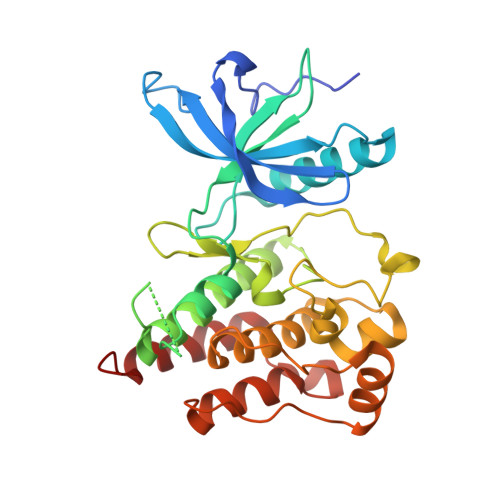Landscape of activating cancer mutations in FGFR kinases and their differential responses to inhibitors in clinical use.
Patani, H., Bunney, T.D., Thiyagarajan, N., Norman, R.A., Ogg, D., Breed, J., Ashford, P., Potterton, A., Edwards, M., Williams, S.V., Thomson, G.S., Pang, C.S., Knowles, M.A., Breeze, A.L., Orengo, C., Phillips, C., Katan, M.(2016) Oncotarget 7: 24252-24268
- PubMed: 26992226
- DOI: https://doi.org/10.18632/oncotarget.8132
- Primary Citation of Related Structures:
5EW8, 5FLF - PubMed Abstract:
Frequent genetic alterations discovered in FGFRs and evidence implicating some as drivers in diverse tumors has been accompanied by rapid progress in targeting FGFRs for anticancer treatments. Wider assessment of the impact of genetic changes on the activation state and drug responses is needed to better link the genomic data and treatment options. We here apply a direct comparative and comprehensive analysis of FGFR3 kinase domain variants representing the diversity of point-mutations reported in this domain. We reinforce the importance of N540K and K650E and establish that not all highly activating mutations (for example R669G) occur at high-frequency and conversely, that some "hotspots" may not be linked to activation. Further structural characterization consolidates a mechanistic view of FGFR kinase activation and extends insights into drug binding. Importantly, using several inhibitors of particular clinical interest (AZD4547, BGJ-398, TKI258, JNJ42756493 and AP24534), we find that some activating mutations (including different replacements of the same residue) result in distinct changes in their efficacy. Considering that there is no approved inhibitor for anticancer treatments based on FGFR-targeting, this information will be immediately translatable to ongoing clinical trials.
Organizational Affiliation:
Institute of Structural and Molecular Biology, Division of Biosciences, University College London, Gower St, London WC1E 6BT, UK.
















